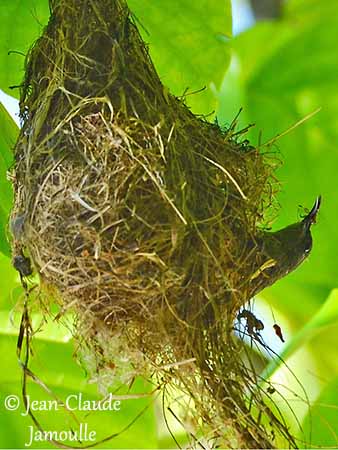
Fr: Souimanga des Seychelles
All: Seychellennektarvogel
Esp: Suimanga de Seychelles
Ita: Nettarinia delle Seychelles
Nd: Seychellenhoningzuiger
Sd: Seychellsolfågel
Photographer:
Jean-Claude Jamoulle
A la rencontre des Oiseaux
Text by Nicole Bouglouan
Sources:
HANDBOOK OF THE BIRDS OF THE WORLD Vol 13 by Josep del Hoyo-Andrew Elliot-Jordi Sargatal - Lynx Edicions – ISBN: 9788496553453
SUNBIRDS by Roberts A. Cheke, Clive F. Mann and Richard Allen Helm, 2001 - ISBN : 1873403801
BirdLife International (BirdLife International)
Seychelles Sunbird
Cinnirys dussumieri
Passeriformes Order – Nectariniidae Family
INTRODUCTION:
The Seychelles Sunbird is not a bright-coloured sunbird, unlike most of Nectariniidae. This species occurs in a variety of habitats from sea-level to 900 metres of elevation. It feeds on nectar and insects. It is endemic to the Seychelles where it is known as Kolibri.
DESCRIPTION OF THE BIRD:
Biometrics:
Length: 12 cm
The adult male has sooty-brown upperparts. On the uppertail, the rectrices are narrowly tipped white. Wing-coverts and flight feathers are darker brown.
On the underparts, chin, throat and breast are metallic dark blue. There is sometimes a faint brownish breast band.
After the second moult, the male shows yellow, yellow-orange or bright orange-red pectoral tufts.
The rest of the underparts are grey-brown, whereas vent and undertail-coverts are whitish. On the undertail, the white tips of rectrices are broader than above.
The downcurved bill is black. The eyes may vary from grey and brown to black. Legs and feet are dark grey to black.

The female has duller plumage and lacks gloss and pectoral tufts. Throat and upper breast show paler-tipped feathers involving indistinct scaly effect. The underwing-coverts are brownish-white, sometimes with yellow tinge.
On the upperwing, the flight feathers are edged olive, and the tail is tipped grey or white.
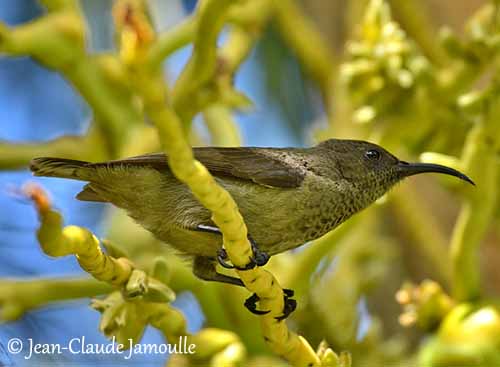
The juvenile resembles female, but it has slightly smaller bill. The underparts are sparsely speckled.
RANGE:
The Seychelles Sunbird is endemic to the Seychelles Islands, and is present on several islands such as Aride, Silhouette, Cousin et Cousine, Praslin, La Digue, Mahé and Fregate.
HABITAT:
The Seychelles Sunbird frequents a variety of habitats such as forest, secondary growth, coconut plantations and farmlands, from sea-level to 900 metres of elevation. It is today mostly confined to the secondary forest on hills. It has adapted to man-made habitats.
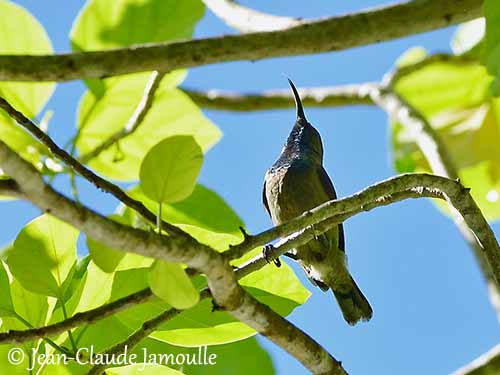
CALLS AND SONGS: SOUNDS BY XENO-CANTO
The Seychelles Sunbird’s call is a “Pseeeu” uttered at two seconds intervals from perch, whereas the contact calls “tsick-tsick” or “tseet” are given in flight or among flowers. The alarm call is “chirr”. We can also hear an insect-like “tzit-tzit”.
The female building the nest utters short “tsuu” or “tsee”, also used when leaving or entering the nest.
The song is a series of 6-20 high-pitched, squeaky and jumbled notes. The song starts slow “dze-dze-dze-dze - and then it becomes faster - der-tseet-tseet-tsit-tsit-tsit” or “pse-pser-eu-eu-tsit”. This phrase can last more than a minute.
Other sounds such as a rattling trill, a rapid purer trill and a complex trilling “chee-chee-chee” are also given by males. The displays, especially the “head-back” display, are accompanied by harsh “chesooty-choo”, with variable intensity, rhythm and pitch.
The female may sing occasionally, usually quieter, less harsh song than male.
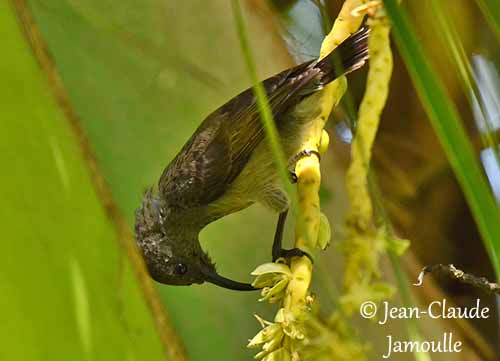
BEHAVIOUR IN THE WILD:
The Seychelles Sunbird feeds on insects and their larvae, spiders (Araneae) and various arthropods. It also feeds on nectar and visits the flowers of numerous plant species.
It forages alone or in pairs, moving fast from flower to flower, spending about one second on each. It forages between six and ten metres above the ground. It may take the nectar directly through the corolla tube, but also by piercing the base of the larger flowers with the bill. It also hovers like a hummingbird in front of Bougainvillea.
It catches insects by gleaning, probing, hovering and flycatching. It also collects insects from spider webs.
They can feed in mixed flocks.
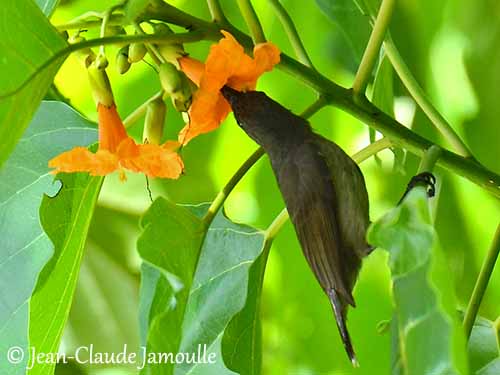
The Seychelles Sunbird is territorial and sites and territories are defended throughout the year.
During the breeding season, the male often calls and sings from high prominent perch. It performs some posturing while singing, with head back and breast expanded to expose the pectoral tufts. It sways side to side.
The following posture shows the male bent forwards almost horizontally, and rocking from side to side. It performs swallowing motions to enhance its glossy blue throat and breast.
The female may sing occasionally. The male chases her. It hangs upside-down beneath branches and moves towards the female while fluttering its wings. The female may also hang upside-down and rotate around a branch while the male pokes under her tail.
The male may also hops from one side of a female to the other, landing on her back en route. Even two males may do this at a time. Prior to copulation, the female crouches down with tail up and spread wings.

Intimidation displays between males are observed during communal feeding at flowering trees. Males are facing each other on a branch and perform similar displays that in courtship, with breast puffed out, vertical bill and well displayed pectoral tufts. These postures are accompanied by a repetitive call and lasts until both males chase each other.
Other displays occur between neighbours, often accompanied by quiet guttural sounds.
The Seychelles Sunbird is known to be polygynous, with a male mated with at least two females, whereas others are monogamous and pair for life.
The Seychelles Sunbird is resident and only performs some inter-island movement, probably related to the flowering trees.
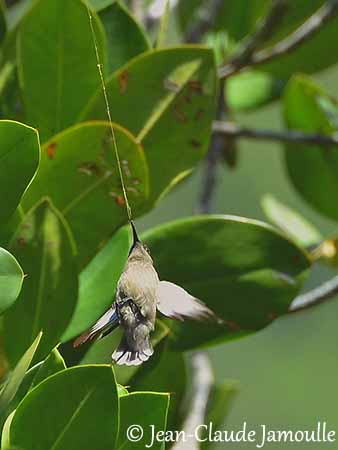
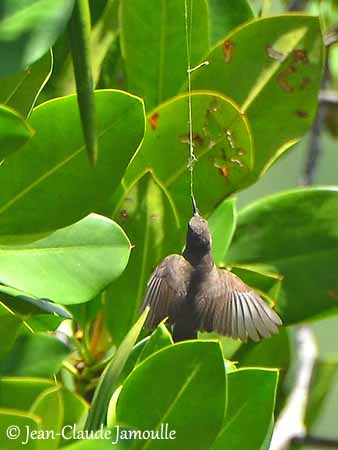
REPRODUCTION OF THIS SPECIES:
The nesting activity occurs in all months except from April to June.
The site is selected by the male, but the female does most of all building. She needs six days to complete the nest, a pear-shaped structure suspended between one and twenty metres above the ground from the end of branch or twig in tree. There is an entrance sheltered by a porch. The nest is made with dried grasses, broad leaves, strips of bark or plant stems, strips of coconut fronds, spider webs, down, feathers and various debris, plant fibres, lichens, roots… It is lined with finer and softer materials.
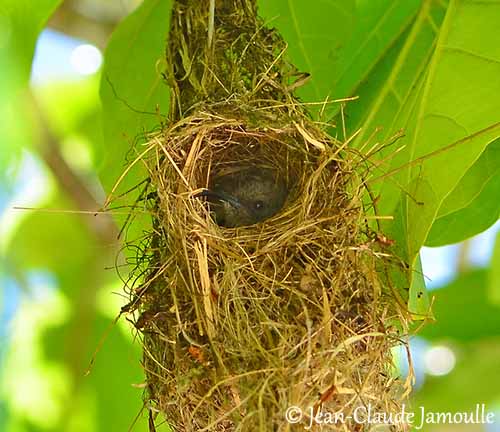
The female lays a single whitish egg with brown spots, and incubates during 11-16 days. She also feeds the chick, sometimes with helpers. The young fledge about 20 days after hatching.
They may produce two or three broods per year, but usually only one.
PROTECTION / THREATS / STATUS:
The Seychelles Sunbird has restricted range, but the species is not globally threatened. It is common on the wooded islands and populations are suspected to be stable.
